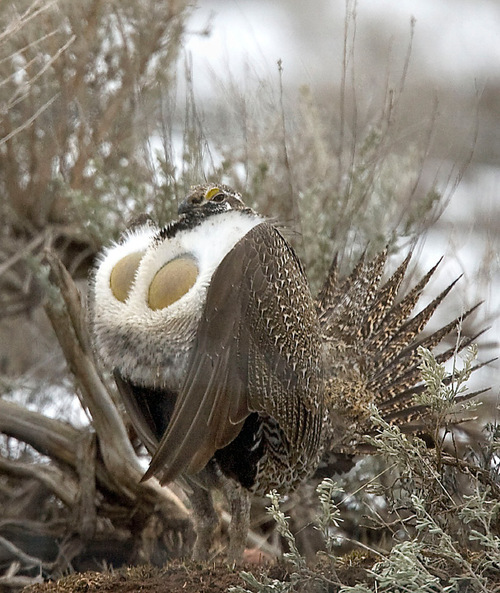This is an archived article that was published on sltrib.com in 2011, and information in the article may be outdated. It is provided only for personal research purposes and may not be reprinted.
The U.S. government is getting serious about protecting sage grouse — gradually — according to conservationists reviewing the latest land-management guidelines.
The Bureau of Land Management released a set of guidelines Tuesday for protecting the imperiled range birds during a planning phase expected to last a couple of years. That part, subject to local BLM managers' case-by-case interpretations, disappoints activists who hoped for immediate restrictions on drilling, mining, grazing and roads in core grouse habitat.
But the agency also released planning directions, including long-term recommendations by a technical team of state and federal biologists. It contains potentially huge changes — such as a 3-mile buffer around the birds' breeding flats — that conservationists believe will help the BLM curtail habitat destruction.
Facing a 2015 review over the bird's potential threatened or endangered status, they believe, the BLM will have to adopt the science it just released to preserve the species.
"It's going to be very difficult for the agency to unring this bell," said Erik Molvar, a wildlife biologist with the Laramie, Wyo.-based Biodiversity Conservation Alliance.
For now, though, he wishes the interim guidelines didn't leave changes to the discretion of local managers.
The legal back story on the declining bird involves a Fish and Wildlife Service decision not to invoke Endangered Species Act protections, followed by a court settlement in which it agreed to reconsider the bird's status in 2015. If the BLM gets to 2015 without adopting what its advisers have now determined are warranted conservation steps, Molvar said, Fish and Wildlife likely will impose its own rules.
The agency's technical team recommended, among other steps: no more than 3 percent of surface disturbance in areas identified as core habitat; just one disturbance site, such as a gas well or new road, per square mile or core habitat; grazing practices that maintain proper function of stream-side riparian areas.
Adopting these guidelines could mean significant protections for grouse from the gas-drilling boom across Wyoming, Colorado and eastern Utah's Uinta Basin, where Molvar said wells and roads have carved up habitat.
"Oil and gas moves in and the sage grouse move out," he said of current conditions.
Limiting and spreading surface disturbance would allow as much production but at some cost to energy companies, Molvar said, because they could drill horizontallyfrom adjacent areas.
The Western Energy Alliance, an industry group that has criticized Obama administration regulation of drill leases, declined to immediately comment because it had not yet reviewed the BLM's guidelines.
The Utah Public Lands Policy Coordination Office — defender of economic development on federal lands — did not respond to an interview request.
"The aim of these science-based measures," BLM Director Bob Abbey said in a prepared statement, "is to maintain and restore flourishing populations of greater sage grouse and sagebrush habitat."
The guidelines appear stronger on oil and gas protections than on grazing changes, said Jim Catlin, executive director of the Wild Utah Project. The BLM is embracing current rangeland monitoring methods, he said, and they don't adequately reflect livestock's impact on grasses that provide cover and insects for the birds.
The BLM should have adopted its technical team's recommendations immediately instead of leaving them to regional management plan updates that could take two or three years to complete, Catlin said. "Nothing that they really need to do for sage grouse can't be done today."
But the Utah Farm Bureau Federation fears the guidelines could reduce livestock numbers on public lands. Those rules call for maintaining habitat when the BLM can control grazing only by livestock and not by increasing elk herds, said Mark Petersen, environmental issues specialist for the federation.
Twitter: @brandonloomis



